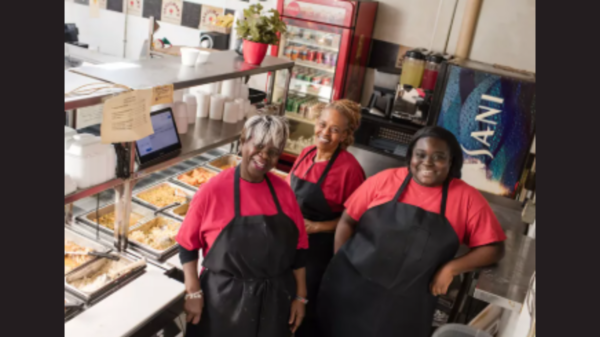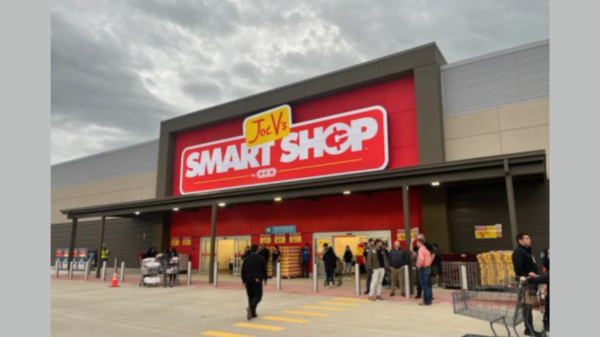KERA | By Diane Solis | Dallas Morning News, Sujata Dand | Dallas Free Press/KERA
The nonprofit Builders of Hope is working with the city of Dallas to create an anti-displacement program categorizing neighborhoods at riskof rapid gentrification.

Emmanuel Glover loves music and art. So much so that when it came to buying their first home, Glover and his wife, Sarah Ashitey, chose the Gilbert-Emory neighborhood in West Dallas.
“We are surrounded by murals and graffiti work,” Glover says, referring to the West Dallas “Tin District” south of Singleton. Jazz music streams through his modern townhome. “ It makes the place beautiful because we are surrounded by art.”
Glover and Ashitey bought their home in spring 2020. Their three-story townhome was one of the first new builds in the area. The price tag: $400,000 dollars.
Glover says it wasn’t until they moved in did they learn that their new house was in a historical African-American settlement. The neighborhood once included one of Dallas’ original segregated schools — the Frederick Douglass School, named for a Black abolitionist. Community members convened the school in West Dallas in the early 1900s, and Dallas ISD closed the school on Bayonne Street in 1980. A neighboring Black church tried to purchase the former school land, but in 2017, Dallas ISD sold it to a private developer.

“After hearing the story and understanding the history of the place, it was very heartbreaking,” Glover says. Glover is an immigrant from Ghana. He and his wife both have degrees in medicine. “Gentrification is difficult to watch, especially if the people affected cannot do anything about it.”
The nonprofit Builders of Hope is trying to do something about it. James Armstrong is the president. He grew up in West Dallas and still lives in the neighborhood.
“The recent events in Gilbert-Emory could serve as a case study of what local municipalities should not do,” Armstrong says.
His organization is dedicated to developing affordable housing. Just over a decade ago, shotgun homes in Gilbert-Emory were valued at $11,000 dollars. Today, they are being replaced by large new townhomes priced above $600,000.
Armstrong says the sale of the former Frederick Douglass school property in Gilbert-Emory led to a domino effect of rapid development and rapid displacement. The Dallas Morning News reported that property values increased by 10 times in just the last 5 years since the sale.
Armstrong is working with the city of Dallas to create an anti-displacement program categorizing neighborhoods at riskof rapid gentrification.

Here are some of the key aspects of the toolkit:
- Crafting the West Dallas Community Vision Plan. West Dallas 1, an association of neighborhood groups, has assisted in gathering resident input through a series of meetings. When finished, the plan will be presented to city officials for approval later this year. Already, the grassroots groups are working with City of Dallas planning officials, Armstrong says.
- Establishing a homeowner preservation and economic empowerment center in West Dallas on Singleton Boulevard, the main thoroughfare of the community. The center will provide tax education on homestead, senior and disability exemptions, plus help homeowners sort through deeds and documents when properties are passed down. Builders of Hope hopes to open the center this fall.
- Building a 36-unit rental development called Trinity West Villas north of Singleton and east of Westmoreland. West Dallas hasn’t had a below-market rental development in several years, Armstrong says. The development is expected to break ground in August. The Dallas City Council authorized a developer agreement with Builders of Hope in June 2022 of about $1.9 million in federal funds for Trinity West, says David Noguera, the City of Dallas’ housing and neighborhood revitalization director.
- Educating residents on home repair assistance through a Builders of Hope program and other existing City of Dallas programs. Assistance can range up to $10,000 in the Builders of Hope program targeting West Dallas, Armstrong said. Builders of Hope is ready to craft solutions to the hurdle of required homeowners’ insurance in certain City of Dallas repair programs, too, he says. Noguera, the housing director, notes that the city manages eight home repair programs, plus programs that will help in clearing titles, an issue that comes up with inherited property.
Heather Way is a law professor at the University of Texas at Austin. She helped create the statewide policy kit on how to reduce displacement in gentrifying neighborhoods. Builders of Hope is using her kit as their template.
Way says many of the strategies promoted by Builders of Hope have worked in Austin and Portland. She says the key is to help homeowners hold on to their properties.
“One of the big lessons learned is permanent affordability,” Ways says. “You must put in community-anchored tools. You have to own land to control land.”
That’s the message Armstrong is passing down to West Dallas property owners.
“We know that preserving existing affordable housing is the most efficient and, oftentimes, the least costly way to assure that affordable housing remains within the community,” Armstrong says. “We lose the fight every time a homeowner sells to a speculative developer.”
Today, Emmanuel Glover is president of the Gilbert-Emory neighborhood association, and he’s working with the few families left in the older homes in the community to hang on to their houses. But, he’s worried he may be too late.
“For each individual now, it’s just a matter of time that your community will be taken over,” Glover says.
He hopes, however, that Gilbert-Emory can serve as a case study on how quickly gentrification happens. The lessons learned, he says, can protect and preserve a community’s identity, even when change is inevitable.
This article was reported and edited cooperatively by The Dallas Morning News, the Dallas Free Press and KERA, which participate in the Dallas Media Collabrative, a group of local news outlets, universities and nonprofits focused on covering affordable housing with a solutions-oriented approach.









